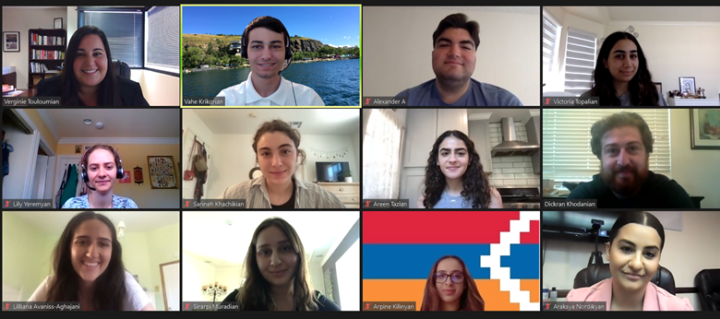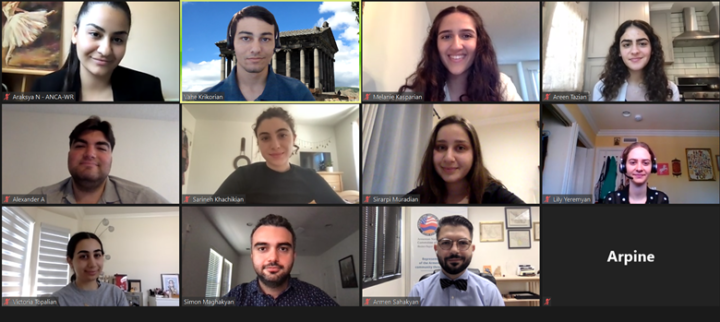Vahe Krikorian
On June 21, 2021, the first day of our second week for the internship, our speaker for the day was Dickran Khodanian the former communications director for ANCA Western Region. The Lecture focused on the Armenians of Javakhk, Georgia. We talked about the region’s early and modern history as well as the conditions of this region. We learned that conditions for Armenians in Javakhk are extremely poor and even discriminatory, there are cases where the government hinders Armenian projects to improve/restore conditions, communities, or religious buildings and monuments. The Georgian government has gone out of its way to prevent Armenians from getting into office, and even if they do make it, the government can and will make it hard for said Armenian. They will resort to Gerrymandering, (or reshaping the districts to redistribute the power or number of representatives) to stop Armenian influence in the Georgian government.
Dickran Khodanian had collected several articles of these instances of oppression, one such article about the people of the region protesting due to a lack of irrigation/drinking water. According to the article, the water problem lasted for more than three months, (as of the publishing date for the article on January 21, 2020) issues such as this have caused the Armenians of the region to move out. Once the Armenians leave for a better life, the Georgians will tear down Armenian churches and buildings to replace them with Georgian buildings. It is theorized that the Georgian government takes these steps to pressure the Armenians out of the region because they do not want a situation similar to Artsakh. Armenians around the world combat the Javakhk issue with several relief programs. The Armenian Relief Society Javakkh Fund has initiated several year-round programs focusing on health care, youth, eductation, social assistance and Armenian culture. Issues like this happen all over the globe, to combat situations like Javakhk people need to bring attention to it. Lectures like this, are exactly what the interns/people our age need to inspire Hye Tahd.

On Tuesday June 22, we had the opportunity to hear from the ANCA-WR Chairperson, Nora Hovsepian. The lecture focused on the concepts of Hye Tahd. We started to talk about the structure of the ANCA, we talked about the connections between the ANCA National Board, ANCA Eastern Region, Western Region, the local chapters and the ANCA advocates. Working in coordination with a network of offices, chapters, and supporters throughout the region and affiliated organizations around the country, the ANCA-WR serves all aspects of the Armenian Cause by organizing and developing local Armenian communities, promoting the political, legal, social, cultural, educational, and economic interests and rights of the Armenian American community at the local, state, regional, and national levels. As well as advocating for all aspects of the Armenian Cause through grassroots mobilization, political relationships, media presence, and education. After talking about the structure of the ANCA, we moved on to the lecture on Hye Tahd. We started with the evolution of Hye Tahd, from the first generation with the Armenian genocide survivors to the fourth generation with the descendants of the genocide survivors; with each generation having a new definition for what it means to fight for the Armenian cause. The (3 R’s) became the theme of the lecture from this point forward, the 3 R’s being Recognition, Reparations, and the Return of Lands.
With the three R’s, learning the methods of countering denial, through defensive/ asking questions related to the genocide, or through offensive approach using academics, public relations, politics, social media, and film and arts. The theme of Hye Tahd continued to the many many ways Armenians help the homeland with support such as U.S. Humanitarian Aid, the American Univeristy of Armenia, supporting democratic institutions and civil rights in Armenia, promoting trade, and millenium challenge grants for STEAM education. There has of course been an increase in support and foreign aid from Armenians all over the world since the recent war with Azerbaijian in 2020. With the increase in foreign aid also came an increase in activities with Armenian community organizations. The Armenian cause has changed and grown stronger since it’s inception with the 1st generation of Armenian genocide survivors, and with recent news of Armenia, Hye Tahd remains an important aspect that should be taught to the Armenian people as well as the Armenian youths. Thanks to our speaker, Nora Hovsepian we learned how intricate the Armenian Cause is and how we at the internship will be involved with Hye Tahd during our time at the ANCA.

On June 23, 2021, we met with Tereza Yerimyan, the ANCA Government Affairs Director, who joined our zoom from Washington D.C. She spoke about the intricacies of the federal government. She told us that lobbyists write the bills and give it to our official government representatives to push it into the state or federal legislature. To that end, she also said lobbyists help make the bill, they get support for the bill, and they help tailor the bill so it may be passed. We the youths of the internship are the head of the Hye Tad movement; therefore we take up work experience like this internship to learn how to walk before we run. We will learn to listen and participate on the political stage using our education and experiences to talk about issues correctly and professionally. Tereza shared about many of her experiences speaking to Congressmembers and staffmembers.

Simon Maghakyan joined the interns on Thursday to speak about the cultural destruction in Armenia, Artsakh, Nakhichevan, and Western Armenia. His research focused on the erasure of historic Armenian buildings, churches, and monuments in lands that historically had been Armenia or had a large Armenian population. We started with a focus on the medieval churches in Nakhichevan, according to data from the Encyclopedia of Nakhichevan Monuments, there were an estimated 89 standing churches/cathedrals, 5,840 cross-stones/ornate headstones, and 22,000 Flat Tombstones between the dates from 1964-1987; Between the dates from 2005-2008, there are almost none if not none left in the region. We learned the ways these numbers were determined, through the use of Eyewitness Testimonies, State Decrees Publications, Visual Crowdsourcing, and Geospatial Data. An example of the Eyewitness Testimony is the systematic destruction of Djulfa, an old Armenian cemetery in old Julfa, there were believed to be thousands of tombstones mainly consisting of khachkars. The State Decrees consist of official documents that ordered many of these churches and monuments to be torn down.
Visual Crowdsourcing is comparing photos taken from many years ago and checking recent photos to spot differences and of course the missing Armenian church or monuments. The last of the ways is checking Geospatial Data, with advancing technology in satellites we are able to observe the geography of the earth with more detail. Using Satellite images, we can see the lands where Armenian churches, monuments, and cemeteries change, almost as if they were being replaced by its surroundings. With satellites, it is easy to see the shadow of an Armenian church in the 1970’s to then witness the land change to either be consumed by trees or even replaced by a new religious building not of Armenian origin. It is said that one of the staged of genocide is the wiping of evidence that the affected people were ever “there”, and cases like these is enough to make even non-Armenian’s blood boil. The churches under the occupation of Azerbaijan and Turkey are continuously being destroyed and looted and the international community must protect these religious sights.

On Friday, June 25, we kicked off our weekly check-in. Araksya Nordikyan, ANCA-WR Karabian Fellow began the meeting with an activity called Rose, Thorns, and Buds where each intern was asked what part of the week/lectures were, interesting, challenging, and if given enough time what has the potential to inspire us to be better. The last activity was an online game of Kahoot where the interns were challenged to answer as many questions correctly as possible with the chance to win a prize. Sirarpi was crowned the winner of the game.

